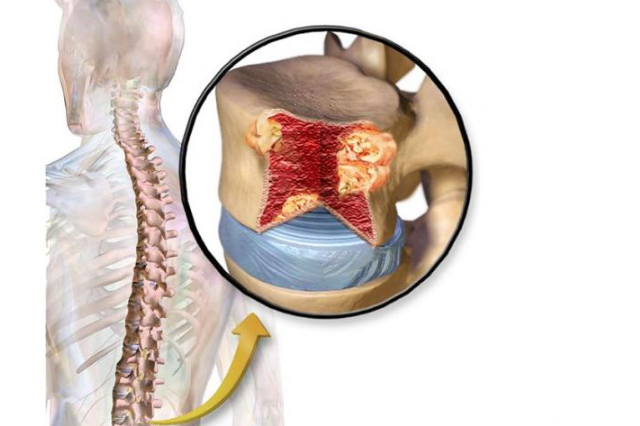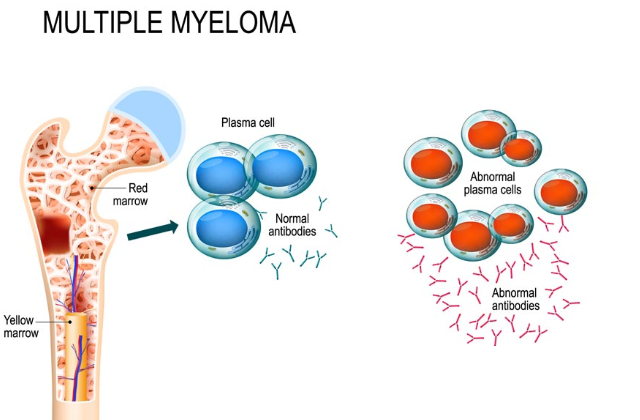The cell is the basic unit of the body, when the cell or cancer cell grew out of control we called it as cancer.These cell can grow anywhere of our body and also spread in to one part to another.
Multiple myeloma is a cancer of plasma cells. Normal plasma cells are found in the bone marrow and are an important part of the immune system. The immune system is made up of several types of cells that work together to fight infections and other diseases. The white blood cell or plasma cell, makes antibodies that fight infections in your body. When you have multiple myeloma, these cells multiply the wrong way. They let too much protein (called immunoglobulin) into your bones and blood. It builds up throughout your body and damages your organs.
There is no cure for this cancer but we can slow the spread of these cells by treatment.
Symptoms
It is difficult to identify the symptoms in the early stage, but over time, you may have:
- Bone pain
- Weakness and fatigue
- Weight loss and loss of appetite
- Upset stomach
- Constipation
- Confusion
- Frequent infections
- Severe thirst
- Weakness or numbness in your arms and legs
Causes

What triggers the malignancy of plasma cells in multiple myeloma is unknown. The cancerous myeloma plasma cells proliferate and crowd out normal plasma cells and can etch away areas of bones. The abnormal cell multiplies rapidly.
Because cancer cells don’t mature and then die as normal cells do, they accumulate, eventually overwhelming the production of healthy cells. In the bone marrow, myeloma cells crowd out healthy white blood cells and red blood cells, leading to fatigue and an inability to fight infections.
The myeloma cells continue trying to produce antibodies, as healthy plasma cells do, but the myeloma cells produce abnormal antibodies that the body can’t use. Instead, the abnormal antibodies (monoclonal proteins, or M proteins) build up in the body and cause problems such as damage to the kidneys. Cancer cells can also cause damage to the bones that increases the risk of broken bones.
Multiple myeloma features
Low blood counts: The overgrowth of plasma cells in the bone marrow can crowd out normal blood-forming cells, leading to low blood counts, which cause anemia (a shortage of red blood cells). Multiple myeloma can also cause the level of platelets in the blood to become low, this can lead to increased bleeding and bruising.
Bone and calcium problems: Bones are constantly being remade to keep them strong. The Two kinds of bone cells, Osteoclasts(break down old bone) and Osteoblasts(lay down new bone) work together to keep bones healthy and strong. The substance myeloma cells make helps the osteoclasts to speed up dissolving the bone. So old bone is broken down without new bone to replace it, making the bones weak and easy to break, this is the reason of Fractured bones problem in people with myeloma.
Infections: Normal plasma cells produce antibodies that attack germs but abnormal plasma cells cannot protect the body from infections. In multiple myeloma, the myeloma cells crowd out the normal plasma cells, so that antibodies to fight the infection can’t be made. The antibody made by the myeloma cells does not help fight infections. That’s because the myeloma cells are just many copies of the same plasma cell – all making copies of the same exact (or monoclonal) antibody.
Kidney problems: Myeloma cells make an antibody that can harm the kidneys, leading to kidney damage and even kidney failure.
Treatments

The treatment of Multiple myeloma is depend on the stages of cancer. Treatment for multiple myeloma may include:
Chemotherapy: Chemotherapy drugs kill fast-growing cells, including myeloma cells. Chemotherapy drugs can be given through a vein in your arm or taken in pill form. Doctors usually give chemo drugs in mixtures. The ones that treat multiple myeloma are:
- Bendamustine (Treanda)
- Cyclophosphamide (Cytoxan)
- Doxorubicin (Adriamycin)
- Etoposide (VP-16)
- Liposomal doxorubicin (Doxil)
- Melphalan (Alkeran, Evomela)
- Vincristine (Oncovin)
Corticosteroids : Corticosteroids, such as prednisone and dexamethasone, regulate the immune system to control inflammation in the body. They are also active against myeloma cells. Corticosteroids can be taken in pill form or administered through a vein in your arm.
Targeted therapies : These medications target proteins, genes, or tissues and prevent cancer from growing.
Immunomodulatory drugs make your immune cells stronger so they can attack cancer cells. They also help starve the myeloma cells in your bone marrow by keeping new blood vessels from forming. Medications include:
- Lenalidomide (Revlimid)
- Pomalidomide (Pomalyst)
- Thalidomide (Thalomid)
We can get easily these medications or prescription drugs from pharmacies, especially online pharmacies, we can purchase the medicine at a discounted price. But not every pharmacy is genuine when you planning to buy from online pharmacies are be aware of that. 984degree, Gdmeds, Apollo are some of the genuine pharmacies in India.
Bone marrow transplant: A bone marrow transplant, also known as a stem cell transplant, is a procedure to replace your diseased bone marrow with healthy bone marrow.The doctors will use a machine to remove some of your stem cells, then freeze and store them. Or they may use stem cells from a donor. Next, you get high-dose chemotherapy, sometimes with radiation. This will destroy almost all the cells in your bone marrow, the plasma cells that cause the disease as well as healthy ones.
Radiation therapy : This treatment uses beams of energy, such as X-rays and protons, to damage myeloma cells and stop their growth. Radiation therapy may be used to quickly shrink myeloma cells in a specific area — for instance, when a collection of abnormal plasma cells form a tumor (plasmacytoma) that’s causing pain or destroying a bone.





